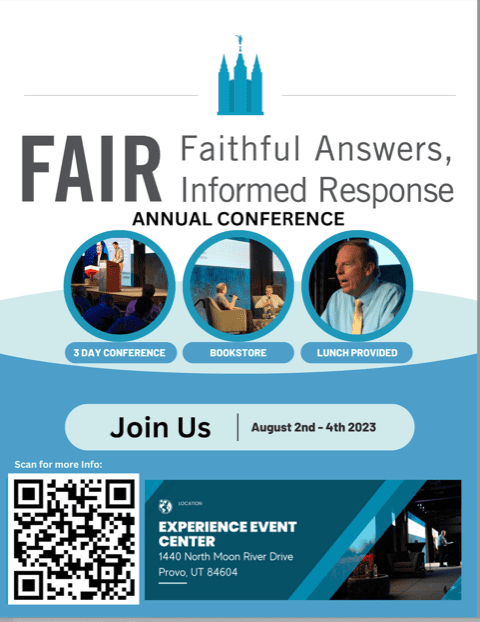
Two new items went up on Friday on the website of the Interpreter Foundation:
“Nephi’s Eight Years in the “Wilderness”: Reconsidering Definitions and Details,” written by Godfrey J. Ellis
Abstract: A traditional reading of Nephi’s chronicle of the trek through Arabia relies heavily on two verses in 1 Nephi 17. In verse 4, Nephi states that they “did sojourn for the space of many years, yea, even eight years in the wilderness.” In verse 5, he reports that “we did come to the land which we called Bountiful.” The almost universal interpretation of these verses is that of sequential events: eight years traversing the arid desert of Western Arabia following which the Lehites entered the lush Bountiful for an unspecified time to build the ship. A question with the traditional reading is why a trip that could have taken eight months ostensibly took eight years. It may be that Nephi gave us that information. His “eight years” could be read as a general statement about one large context: the “wilderness” of all of Arabia. In other words, the “eight years in the wilderness” may have included both the time in the desert and the time in Bountiful. In this paper I examine the basis for such an alternative reading.
“Interpreting Interpreter: Eight Years in the Wilderness,” written by Kyler Rasmussen
This post is a summary of the article “Nephi’s Eight Years in the “Wilderness”: Reconsidering Definitions and Details” by Godfrey J. Ellis in Volume 57 of Interpreter: A Journal of Latter-day Saint Faith and Scholarship. An introduction to the Interpreting Interpreter series is available at https://interpreterfoundation.org/interpreting-interpreter-on-abstracting-thought/.
The Takeaway: Ellis argues that Nephi’s reference to “eight years in the wilderness” includes the time spent in Bountiful, allowing us to set concrete estimates for Nephi’s travel and shipbuilding efforts, and making it unnecessary to explain that time by positing extended stays in desert regions.

Not infrequently, I run across the claim that, because there are several ancient stories of divine beings who die and then come back to life, the story of the resurrection of Jesus can therefore be dismissed is merely yet another of these old folk tales and legends. I responded briefly and rather generically to this sort of assertion in a column for the Deseret News that was published clear back in mid-May 2012. (See my “‘Parallels’ of prophets not parallel.”)
There are several solid responses to this particular, umm, argument. One of them, from Andrew Loke, Investigating the Resurrection of Jesus Christ: A New Transdisciplinary Approach (Routledge, 2020), runs as follows:
What if we told you about a British ocean liner that was about eight hundred feet long, weighed more than sixty thousand tons, and could carry about three thousand passengers? The ship had a top cruising speed of twenty-four knots, had three propellers, and about twenty lifeboats. What if I told you that this ocean liner hit an iceberg on its maiden voyage in the month of April, tearing an opening in the starboard side, forward portion of the ship, sinking it along with about two thousand passengers? Would you recognize the event from history? You might say, ‘Hey, that’s the Titanic!’ Well, believe it or not, you would be wrong. It’s the Titan, a fictional ship described in Morgan Robertson’s 1898 book called The Wreck of the Titan: or Futility. This book was written fourteen years before the disaster took place, and several years before construction began on the Titanic! (Robertson, WT, website). Here is the point: just as the fictional account of the Titan does not undermine the reality of the sinking of the Titanic, fictional accounts of dying and rising gods would not undermine the historical reality of the life, death, and resurrection of Jesus. The presence of parallels alone proves nothing about borrowing or the historicity of Jesus. (11)
Here’s another interesting passage from Dr. Loke. Some ask why there are no ancient references to the supposed resurrection of Jesus outside of the Bible. But, of course, there are:
Jesus’ crucifixion is attested by a number of ancient sources, both Christian and non-Christian. Outside of numerous references in the New Testament, it is mentioned in numerous early Christian writings and non-Christian writings such as Josephus’ Antiquities of the Jews 18.3,1 Tacitus’ ‘the most extreme penalty,’ Annals 15.44,2 and Lucian’s The Death of Peregrine, 11. . . .
Aside from Paul’s letters, other documents in the first and early second century—such as the Four Gospels, Acts, 1 Clement, Letters of Ignatius, etc.—also claimed that various people witnessed the resurrected Jesus. As noted earlier, some of these claims were discussed by Celsus, a non-Christian philosopher who wrote an attack on Christianity titled The True Word in c. AD 177–180, most of which was preserved in the rebuttal by Origen written in AD 248 (Marcovich 2001, p. 14; Celsus’ attack on the Gospels indicates that he did not accept them uncritically). An earlier non-Christian reference (c. AD 140) was made by the Greek historian Phlegon in his ‘Chronicles,’ also preserved in the aforementioned rebuttal by Origen (Contra Celsum, 2.59). It states, ‘Jesus, while alive was of no assistance to himself, but that he arose after death, and exhibited the marks of his punishment, and showed how his hands had been pierced by nails.’ It is unlikely that Origen fabricated what Phlegon wrote, given that it would have been easy for his readers to find out and given the awkwardness of the phrase that Jesus was ‘of no assistance to himself’ while alive. . . .
While some scholars suspect that Christians may have distorted parts of Josephus’ reference to Jesus, the vast majority of scholars regard the references to Jesus as the brother of James, Jesus as a miracle worker, and his crucifixion as authentic. For a balanced discussion of the reasons for and against authenticity, see Paget (2001); Meier (1991–2016, Vol. 1, pp. 56–88). . . .
This reference in Tacitus is most likely authentic, for the Latin style is Tacitus’, the tone is anti-Christian, and all the manuscripts of Tacitus have this passage (Meier 1991–2016, Vol. 1, pp. 90–91). . . .
We know from subsequent history that Jewish writers were in the main unwilling to engage polemically with Christianity in their extant writings, a point exemplified not only in later rabbinic writings, but also, if we are to believe Photius, in the one writing he attributes to Josephus’ contemporary and enemy, Justus of Tiberias. It would be wrong to assume that such people simply knew nothing about Christianity, or that they were unacquainted with Christians. Their silence could have been illustrative of their contempt for, or embarrassment about, Christianity, rather than their ignorance. (8-9)













